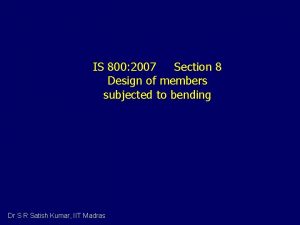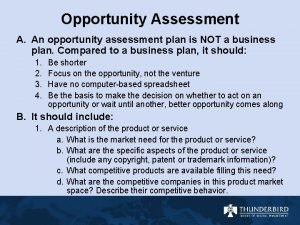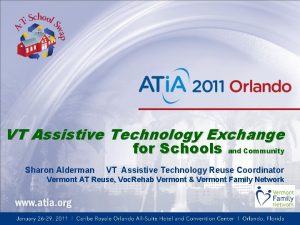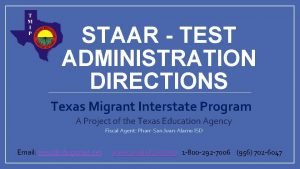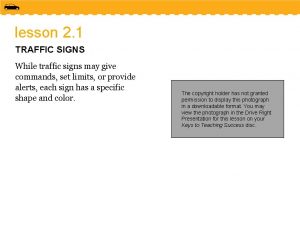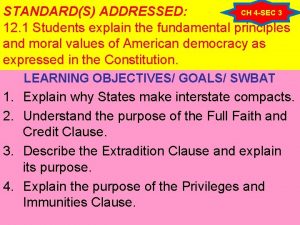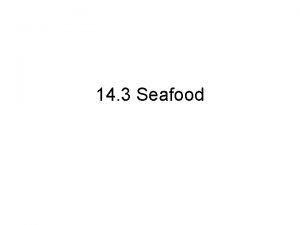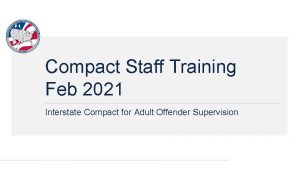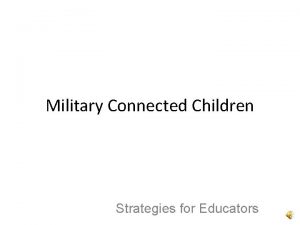Interstate Compact on Educational Opportunity for Military Children



















- Slides: 19

Interstate Compact on Educational Opportunity for Military Children Brigadier General (retired) Norman E. Arflack Executive Director

Compact Overview and Introduction • The goal of the compact is to replace the widely varying policies that affect transitioning military students with a comprehensive approach that provides a consistent policy in every school district and in every state that chooses to join. • The compact addresses key transition issues encountered by military families including enrollment, placement, attendance, eligibility and graduation. • Children of active duty members of the uniformed services, National Guard and Reserve on active duty orders, and Members or veterans who are medically discharged or retired for (1) year are eligible for assistance under the compact Note – the compact applies to public schools only.

Purpose • Inform schools and families about the progress of the compact implementation – What the compact does and doesn’t cover – Timeline for execution • Manage expectations as some schools and families may think – Compact addresses more educational areas/issues than it does – Compact will be fully operational from the minute it is adopted

Major Points • Compact designed to resolve recognized education transition issues • Compact not intended to impact curriculum or local standards of education – Recognizes responsibility of states and local education agencies – Would have been a major obstacle in obtaining state buy-in – The Department of Education is leading a task force examining national standards

• • Background and Status Developed by The Department of Defense, with the assistance of The Council of State Governments Input and assistance from national associations, federal and state officials and departments of education and superintendents Adopted by 46 states and the District of Columbia(approximately 97 percent of military school-age children in the US) as of May 2013 Initial meeting of the governing Commission was Oct ’ 08 Second Commission meeting was in Nov’ 09 States are in the process of establishing internal Councils Rules and Executive Committees have been meeting since 2009 Compliance, Finance, and Training Committees began meeting in 2010

Compact Content • • • Article I – purpose Article II – definitions Article III – applicability Article IV – enrollment Article V – placement and attendance Article VI – eligibility Article VII – graduation Article VIII – state coordination Article IX – interstate commission

Article IV - Enrollment: Educational Records What’s included: • Parents can receive a copy of unofficial records • Receiving school must accept the unofficial records to enroll and place the student pending reception of official records • Sending school must send official records within 10 business days of receiving a request from the receiving school. What’s not covered: • Giving parents the right to request a copy of every paper in the student file • Receiving unofficial records free of charge

Article IV - Enrollment: Immunizations What’s included: What’s not covered: • Child is given 30 days from enrollment to obtain required immunizations • TB testing: since it is a test rather than an immunization, the test may be required before enrollment • A series of immunizations must be started within 30 days of enrollment

Article IV - Enrollment: Kindergarten and First Grade Entrance Age What’s included: • In the case of a Kindergarten student, the student must have been enrolled and attended class in the sending state in order to assure continued attendance in Kindergarten in the receiving state • A student that has satisfactorily completed the prerequisite grade level in the local education agency in the sending state shall be eligible for enrollment in the next highest grade level in the receiving state, regardless of age. What’s not covered: • A student who has not been enrolled and attended kindergarten even though they are of eligible age to have started.

Article V - Placement and Attendance: Course and Educational Program Placement What’s included: • Receiving state will initially honor placement in courses or programs based on the student’s enrollment in the sending state • Receiving state may subsequently perform an evaluation to ensure the appropriate placement and continued enrollment What’s not covered: • Guarantee of continued enrollment if not qualified • Although the receiving school must demonstrate reasonable accommodation, there is no requirement to create a course or additional space

Article V - Placement and Attendance: Education Services What’s. Special included: What’s not covered: • Receiving state will initially provide the same services identified in the students Individual Education Plan from the sending state • Receiving state may subsequently perform an evaluation to ensure the appropriate placement of the student • A requirement to provide the exact programs as sending state • Anything above the requirements in the IDEA

Article V - Placement and Attendance: Placement Flexibility What’s included: What’s not covered: • Allowing flexibility to the Local Education Agency (LEA) to waive course or program prerequisites or other preconditions if similar course work has been completed in another LEA. • Mandatory waivers of prerequisites or preconditions

Article V - Placement and Attendance: Absence Related to Deployment Activities What’s included: • Flexibility for additional excused absences to visit the parent or legal guardian due to deployment Note: Deployment window is defined as one month before the member’s departure from her/his home station through six months after return to her/his home station What’s not covered: • Requiring more than “reasonable accommodation” Note: this provision provides discretion and flexibility to the LEA and school superintendent during state testing periods or if the student has already missed so much school that additional absences will be detrimental

Article VI – Eligibility: Eligibility for Enrollment What’s included: • A LEA cannot charge tuition to military children placed in care of a non-custodial parent or person serving “in loco parentis” • A student can continue to attend his or her current school even if living with a non-custodial parent or person serving “in loco parentis” • The power of attorney for guardianship is sufficient for enrollment and all other actions requiring parental participation or consent

Article VI – Eligibility: Eligibility for Extracurricular Participation What’s included: • State and local agencies shall facilitate the opportunity for inclusion in extracurricular activities regardless of deadlines as long as the child is otherwise qualified What’s not covered: • State student athletic associations, some of which are not affiliated with state or LEAs • Although the receiving school must demonstrate reasonable accommodation, there is no requirement to hold open or create additional spaces

Article VII – Graduation What’s included: • Waiving courses required for graduation if similar course work has been completed in another LEA • Flexibility in accepting sending state exit or end of course exams, national achievement tests, or alternative testing in lieu of testing requirements for graduation in the receiving state • Allowing a student to receive a diploma from the sending school as an alternative to accommodations for exit exams and graduation requirements that the student doesn’t have time to meet • Should a waiver not be granted to a student who would qualify to graduate from the sending school, the LEA shall provide an alternative means for acquiring course work so graduation may occur on time. What’s not covered: • Mandatory waivers…. although LEA must show good cause for a denial of waiver • Mandatory waiver of the exam or acceptance of alternative results • The right of parents to request a change of graduation requirements in the receiving LEA

Reference Resources • Interstate Commission and State Council information http: //www. mic 3. net • FAQs http: //www. mic 3. net/pages/FAQ/faq_indexnew. asp x

The Compact provides a valuable tool to help our families!

Questions? ? BG(R) Norman E. Arflack Executive Director Interstate Commission on Educational Opportunities For Military Children 2760 Research Park Dr. P. O. Box 11910 Lexington, KY 40578 -1910 (859) 244 -8069 narflack@csg. org
 Web buckling and web crippling slideshare
Web buckling and web crippling slideshare An opportunity assessment plan:
An opportunity assessment plan: Ramapo eof
Ramapo eof New mexico interstate stream commission
New mexico interstate stream commission Interstate resources
Interstate resources 津川 知朗
津川 知朗 Texas migrant interstate program
Texas migrant interstate program La crosse county fair
La crosse county fair Local state us and interstate route signs
Local state us and interstate route signs Why might states feel the need to form compacts
Why might states feel the need to form compacts Driver license
Driver license Abram interstate insurance
Abram interstate insurance Which organization monitors interstate fish shipments?
Which organization monitors interstate fish shipments? Chapter 4 section 3 interstate relations answer key
Chapter 4 section 3 interstate relations answer key Interstate vs intrastate commerce
Interstate vs intrastate commerce What is the proposed route for interstate 11
What is the proposed route for interstate 11 Trög för kemist
Trög för kemist Jiddisch
Jiddisch Ledarskapsteorier
Ledarskapsteorier Datorkunskap för nybörjare
Datorkunskap för nybörjare
